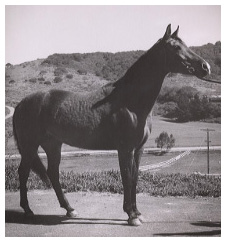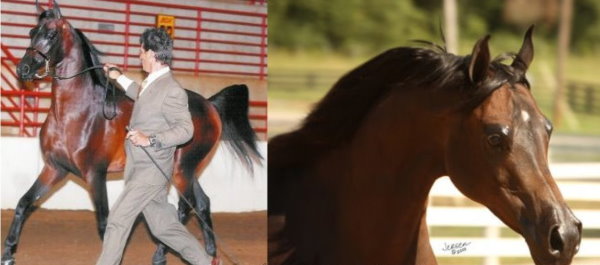
Left Mezmarize Top 3 U.S. Nationals year old colts - Right Uptown Fame, his dam
The Arabian Horses of Poland
by Arlene Magid
© All articles contained in our website are copyrighted. All rights reserved. Any use by you of these pages without prior written will be prosecuted. Arlene Magid
The history of the Arabian horse in Poland is one closely allied with the fortunes of war. Lacking natural boundaries, Poland was subject to frequent invasions by foreign armies, including those by warriors mounted on horses of Eastern blood: swift, durable, and tough. The Polish nobility responsible for the nation's defense captured many of these horses as prizes of war and they were bred to both native stock and to each other to enhance the horses used in cavalry maneuvers. When a truce was agreed upon with the Turks in 1699, the immediate supply of Arabians was cut off, so expeditions to the desert were mounted periodically to obtain new blood to refresh breeding stock currently in use. Arabians were as useful in peacetime as they were during times of conflict, for upgrading the horses that worked the fields, or pulled the carriages of the nobility.
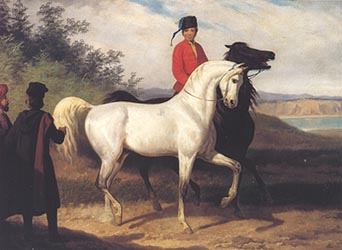
Horses in modern Polish breeding are largely descended from those bred at the studs of some of the Polish princes in the nineteenth century. One of the most important of these was the Slawuta stud of the Sangusko family. Milordka, whose descendants can be found worldwide today, was foaled at Slawuta in 1816. From her descend such notables as *Witez II (the first Pacific Coast Champion Stallion), multi-National Champion *Gwalior,++ U.S. National Champion Stallion *Aramus++, Aquinor (the first Polish bred stallion to sire a U.S. National Champion Stallion and Mare), U.S. National Champion Mare *Elkana++, etc. Another significant dam line originating at Slawuta is that of Ukrainka, represented today through the incredible broodmare Forta, who produced 17 race winners from 19 foals. Forta has also had much influence on show horses, as the breed's leading living dam of champions, TW Forteyna, is a paternal granddaughter of hers. The female line of Szweykowksa, another Slawuta mare, has yielded such notable as *Naborr, sire of U.S. National Champion Stallions *Aramus++ and Gai Adventure and U.S. National Champion Mare and Reserve National Champion English Pleasure *Dornaba++. Yet another Slawuta mare, Woloszka, founded the dam line that produced U.S. National Champion Stallion *El Paso and U.S. National Champion Mare Kajora. One of the major sire lines in Polish breeding that originated at Slawuta is that of Ilderim, who was purchased in 1900 in Constantinople. Notables of this sire line include Aquinor (sire of U.S. National Champion Stallion *Elkin++ and U.S. National Champion Mare *Elkana++), Polish Reserve National Champion Stallion Partner, and European and Polish National Champion Stallion *Penitent (sire of U.S. National Champion Mare *Kawalkada).
Another nineteenth century stud of great importance was that of Count Julius Dzieduszycki, who made a two year journey to Arabia in 1843 and returned with three legendary mares: Gazella, Mlecha, and Sahara, to who many Polish horses trace in tail female today. Gazella's line has yielded U.S. National Champion Stallion AAF Kaset+, U.S. National Champion Mare *Kawalkada, *Naganka (dam of multi-National Champion Bay El Bey++), and Comet (sire of U.S. National Champions in park and english pleasure), to name just a few. The female family of Mlecha has produced Polish Oaks and Derby winner *Sabellina (foundress of a dynasty of successful racehorses in Poland and America), U.S. National Champion Stallion and Park *Bask++ and his full sister Bandola, and U.S. National Champion Mare *Arwistawa++ (whose dam is *Bask's full sister Arfa). Sahara's line has bred on successfully in Poland and in Russia, from the Russian branch have come the U.S. National Champion Stallions *Muscat and *Marsianin; and in Poland, the U.S. National Park Champion *Meczet. In 1876, Count Juliusz bought through his agent in Constantinople the important stallion Krzyzyk, from whom descends Trypolis, British National Champion Stallion Banat, and the sensational racehorse Kaszmir (whose paternal granddaughter *Arwistawa++ is a U.S. National Champion Mare).
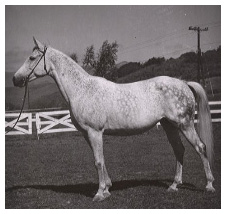 |
||
| *Naganka |
Mention must be made of the Antoniny Stud of the Potocki family, also founded in the ninenteenth century. The best known horse there was the spectacular Ibrahim, bred in the desert and bought in 1907 in Constantinople by a dealer for Count Joseph Potocki. Ibrahim died during the Bolshevik revolution in 1917 (Antoniny was at that time in land that was considered Russian), but his immortality in Arabian horse history was guarnteed by his son Skowronek, foaled in 1909 and later exported to England. Ironically, due to the turmoil of twentieth century war, the Ibrahim sire line was lost to Poland until its reintroduction with the importation of *Naborr from Russia in 1956. (*Naborr's paternal grandsire Naseem was a Skowronek son bred in England).
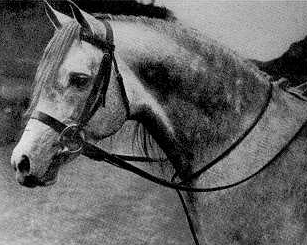
Naseem
The political upheavals of World War I wiped out most of the breeding studs of the Polish aristocracy. Poland was declared an independent nation in 1921 (a status it retained until the Russian and German invasions of 1939) and breeding continued at the Polish State Stud at Janow Podlawski. The stud at Janow had been founded in 1817 by royal command of Tsar Alexander I of Russia (also then King of Poland), but there was little pure Arabian breeding until after World War I, as Janow's emphasis initially was on breeding high quality saddle horses sired by Arabian stallions out of grade mares. The first purebred mares to go to Janow included the beautiful Koalicja (granddam of *Witez II) and in 1920 the stud obtained a number of important mares, including Gazella II, Pomponia and Zulejma from the dispersal of the Dzieduszycki stud at Jezupol. Other horses came from the Weil Stud of Germany, Inocenzdvor (in Yugoslavia) , the Pompadour Stud of France, the Babolna Stud (Hungary) and a few private breeders in Poland. One significant private breeder in the interwar period, Baron Bicker, imported horses from England's Crabbet Stud, including Fasila, Rasim and Sardhana, all of whom have surviving lines in Polish breeding today(U.S. National Champion Stallion *El Paso's traces to Bicker breeding through his dam).
Arabian breeding thrived in Poland during the years between World Wars I and II, and in 1927 the Polish Arab Horse Breeders Society was formed.. The Society issued the first Polish national stud books (prior records had been kept by individual studs and many were destroyed during World War I). The Society also started the practice of Arabian racing in Poland as a tool to test traits valued by the Poles: stamina, athleticism, and attitude. Today, nearly all race days in Poland feature Arabian competition, and race training and testing is obligatory for horses of the State Studs.
In 1931 two very important stallions were obtained for the Gumniska Stud of Prince Roman Sangusko by his agent who went to the desert to locate new stallions. The first was the grey Kuhailan Afas, whose son Bad Afas (out of the French mare Bad) sired *Naganka (dam of multi-National halter champion Bay El Bey++ and U.S. National Champion Park Mikado++) and Abu Afas, sire of the great race mare *Sabellina and the motion sire Comet. The other stallion was the unforgettable Kuhailan Haifi, the founder of one of the world's most successful sire lines through his son Ofir, born in 1933. Ofir stood just two seasons in Poland but his sons Wielki Szlem and Witraz were to have profound impact on breeding in Poland, while his son *Witez II, imported to America in 1945, was highly influential here (he is the paternal grandsire of U.S. National Champion Stallion Zarabo and U.S. National Champion Mare Indian Genii. Ofir's daughter Mammona went to Russia as a foal in 1939 and became a mainstay of the breeding program at the Tersk Stud there (she is the granddam of U.S. National Champion Stallions *Muscat and *Marsianin). Ofir himself was a prize of war for the Russians in 1939 and ended his stud career at Tersk.
Americans discovered the horses of Poland in the 1930s and made their first importations then. General Dickinson of Tennesee brought in two groups of horses in 1937 and 1938. There remain a few pure Polish Arabians with the blood of the Dickinson imports today. Dickinson also exported the stallion Antez (of straight Davenport bloodlines) to Poland, where he sired Polish Derby winner Hashim Bey (who won the last Derby run in Poland until after World War II). Many of Dickinson's Polish imports have National winners tracing to them (multi-National Champion Park horse Zodiac Matador being one example).
In 1938 Henry Babson of Chicago imported a group of Polish Arabians which included the stallion *Sulejman and the mares *Kasztelanka and *Azja IV. Their blood has not continued in pure Polish stock in America, but has been influential nonetheless, with *Sulejman appearing in the pedigrees of a number of National winners, *Kasztelanka being the granddam of U.S. Reserve National Champion Stallion Fadjur (and appearing twice in the pedigree of U.S. National Champion Stallion Khemosabi), and *Azja IV the dam of the top-siring son of *Raffles, Azraff. Azraff sired U.S. National Champion Stallion Galizon and is the maternal grandsire of U.S. National Champion Stallion and Pleasure Driving Gai Parada.
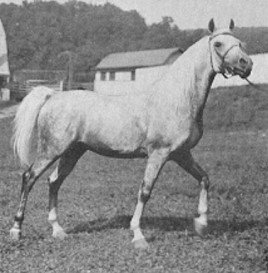
*Raffles
World War II decimated the private studs of Poland and nearly destroyed Arabian breeding entirely. The Russians invaded and took a large group of horses back to Tersk, and then the Germans removed a good many more. Many horses were killed before the dedicated Poles could hide them from their invaders. Of the 195 mares at Janow in 1939, no less than 143 perished or disappeared. In 1946, 30 broodmares, 12 foals and the stallions Witraz, Wielki Szlem and Amurath Sahib were able to return from their exile within Germany, but not to Janow which was so badly damaged that Arabian breeding there did not start again until 1960. While Janow was being repaired, its horses were distributed among three new state studs: Nowy Dwor, Albigowa (where *Bask was foaled in 1956), and Klemensow. In 1951 the latter was moved to its present location at Michalow.
As part of the effort to rebuild the Polish Arabian community after the war, a group of mares from Hungary's Babolna Stud was sent to Poland, leaving great influence on the breeding program there. Representing the Babolna dam line of Adjuze was Blaga, who cam to Poland in 1946. Her son Doktryner was a chief sire for many years, among his get are U.S. National Champion English Pleasure *Muzulmanin++ and *Gawra, dam of 7 American champions. Another Babolna mare, Brda (of the 216 Semrie family) is the granddam of Arax (sire of U.S. Reserve National Champion Mare *Boltonka and a number of significant get upon his exportation to Russia). Brda also produced Darda, dam of U.S. National Champion Mare *Dornaba++ and *Druchna (second dam of U.S. and Canadian National Champion Stallion MS Santana). Arriving in Poland in 1948, the Babolna mare Baza (also of the 216 Semrie female line) produced National winner sire Czardasz and Polish Derby winner Branibor (a sire of stakes winning racehorses as well). Bulwa (of the 214 Scherifa dam line) arrived in Poland in 1949. Her notable descendants include the Polish National Champions *Aloes, Algeria, and *Algomej and U.S. Reserve National Halter Champions *Boltonka++ and *Buszmen. The Babolna mares were returned to Hungary in 1951.
Americans were reminded of the quality of the Polish horses in 1945, when a group of horses dramatically rescued from the Czechoslovakian stud of Hostau arrived from Europe. (They had been cached there by the Germans). In this exceptional group were *Witez II, *Chloe (maternal granddam of U.S. National Champion Mare Chloette++), *Wierna (maternal granddam of U.S. National Champion Stallion Bay Abi++), and *Iwonka III (maternal granddam of *Bask++ whose daughter Balalajka remained in Europe). The horses of this group were resold by the U.S. Army upon the disbanding of the cavalry in 1949, and a few are still found in pure Polish horses in America today.
After World War II Poland slipped behind the Iron Curtain, and exportations to countries outside the Soviet bloc stopped until Patricia Lindsay of England went to Poland in 1958. She was enthralled with the horses she found there, and eventually exported a number for herself (she is the breeder of the dam of U.S. National Champion Stallion *Aladdinn, for example), and became the agent for sales of Polish Arabians to America. In 1961 several California breeders made importations through Patricia, and among the horses brought in were *Corsair (sire of the leading broodmare Susecion, who produced 2 U.S. National Champion Mares), *Szarza (dam of U.S. Reserve National Champion Stallion Amerigo, sire of Khemosabi++++), U.S. National Champion Park *El Mudir, *Naganka, *Bachantka and *Ostroga (who became cornerstones of the Varian program), and U.S. National Champion English Pleasure *Muzulmanin++. It was seeing *Muzulmanin++ that inspired Dr. Eugene LaCroix to go to Poland to investigate the horses there. In
1963 he made a landmark importation that included such stars as *Bask, *Boltonka++, *Gwadiana (the all time leading Polish dam of champions with 9 to her credit), U.S. National Champion English Pleasure *Wirginia, and *Mesalina (dam of 7 American champions including U.S. National Champion Park Mieczych). On the same ship as the LaCroix group came the first imports for another Arizona breeder, Ed Tweed, including the Top Ten halter stallions *Gwiazdor and *Czester++, as well as *Naborr, who had been bought by Anne McCormick. Howie Kale brought in *Dornaba++ as well. The Polish invasion of America had begun in earnest.
*Ostroga |
|
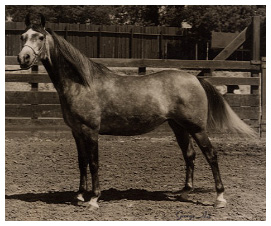 *Bachantka
*Bachantka
One of the few advantages for the Poles of their political ties to Russia was the opportunity to obtain breeding stock from the Tersk Stud, which had many horses whose lines had been lost to Poland during the war. In 1958 *Pietuszok was brought to Poland. He represented the sire line of Koheilan Adjuze through his grandsire Piolun, who had gone from Poland to Russia in 1939. He left a significant heritage in Poland as he crossed very well with Witraz daughters. Among his most important get were Polish Derby winner and National winner sire *Wosk, his full sister *Wilma (dam of the American racing sensation *Wiking), U.S. National Champion Racehorse and multi- National winner in halter and performance *Orzel++, and Canadian National Champion Stallion *Bajram. *Pietuszok was exported to Canada at age 19. His full sister Potencja was also brought to Poland, where she won the 1955 Derby and founded a dam line of her own. The postwar period also saw the return of the Szamrajowka dam line to Poland through Prowierka and Piewica.
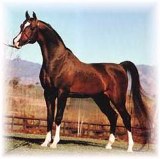
Khemosabi
Prowierka(imported in 1956) had just one foal, the Derby winner Prowarda, herself dam of U.S. National Champion Park *Prowizja. Piewica(imported in 1958) had six foals in Poland, and many recent show ring stars trace to her in tail female, among them *Penitent, Polish, European, World and British Champion Mare *Pilarka, multi-National winner in halter and english pleasure *Perkal, and multi-National Champion *Piechur, now in England.
The Russian connection also brought a sire line that had been lost to Poland back again--that of Ibrahim. Its first representative in Poland after World War II was *Naborr, imported in 1956. After he had sired a number of excellent foals in Poland, the Poles obtained his sire Negatiw in 1962 and sold *Naborr to America. Negatiw died in 1973 after siring many superb foals, among them Polish chief sire *Bandos (out of Bandola) , *Kaseta (dam of U.S. National Champion Stallion AAF Kaset), and Canadian National Champion English Pleasure *Tinian. Twenty eight Negatiw get produced North American National winners.
Another important influence added to Polish breeding through imports from Russia was that of Aswan, bred in Egypt and given as a gift to the Russian government. Four sons of Aswan were used at stud in Poland, including*Magnat, who came to Poland in 1968 (where he sired Derby winner Sanos) and was exported to the U.S. in 1969. The most important Aswan son used in Poland was Palas, sire of Polish National Champions as well as U.S. National Champion Mare *Penicylina and Canadian National Champion Mare *Camea. The Aswan daughter Parma, imported to Poland in 1968, has produced more Polish National Champions than any other mare.
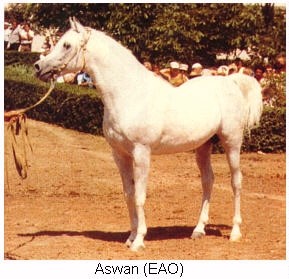
Currently there are three state studs in Poland, and with the end of the Communist regime a number of private ones as well. The State Studs include Janow Podlawski, Michalow, and Bialka, established in 1982. Each August the "Polish Arabian Summer Festival" is held, which features the Polish National Show, an international racing day, and a public auction, the Polish Prestige Sale, held at Janow Podlawski. (There is also a "silent" sale with sealed bids held at the Warsaw racetrack).
The international influence of Polish breeding can be summed up with two recent examples. The American born stallion Monogramm (a paternal grandson of *Bask and a son of the Russian born mare *Monogramma) was leased by the Polish governement for three breeding seasons to introduce the *Bask branch of the Witraz sire line to Poland. His get there have been a smashing success on both the racetrack and in the show ring. In 1997, at the Polish Prestige Sale, the 1996 Polish National Champion Stallion and 1994 Polish Derby and Criterium winner Batyskaf was offered. He sold for the record price of $425,000 to the Turkish government. He will be used on the formerly closed breeding herd of the Turkish National Stud, an enormous honor. In former times, Poland was a country much conquered, but in the twentieth century, the Arabian horses of Poland have captured the hearts of breeders worldwide.
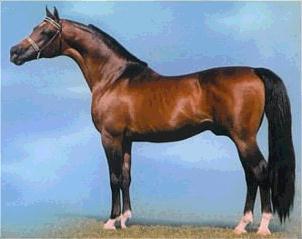 |
||
|---|---|---|
| *Bask |
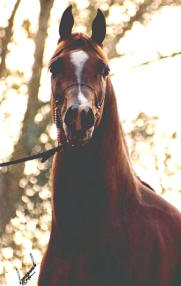 Monogram
Monogram
©2024
Above is restricted from use by others without
written permission of the author.
![]()
